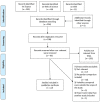Are Modern Head-Mounted Displays Sexist? A Systematic Review on Gender Differences in HMD-Mediated Virtual Reality
- PMID: 32903791
- PMCID: PMC7438857
- DOI: 10.3389/fpsyg.2020.01604
Are Modern Head-Mounted Displays Sexist? A Systematic Review on Gender Differences in HMD-Mediated Virtual Reality
Abstract
Modern head-mounted displays (HMDs) are a promising technology. Thanks to their affordable cost and versatility, HMDs are gaining attention from different sectors. However, the experience reported by the users of these technologies is sometimes negative. A number of people, when using an HMD, complain of various types of physical discomfort as well as symptoms like headache, disorientation, and nausea. These symptoms, developed during or after exposure to virtual environments, are commonly referred to with the term simulator sickness. Some scientific studies have shown that women are commonly more sensitive to simulator sickness. However, a gender imbalance in the susceptibility to simulator sickness has not been widely studied in the context of modern HMDs, and the studies that have been done have reported heterogeneous findings. The present systematic review aims to gather the pieces of evidence that support and oppose a gender difference in the susceptibility of simulator sickness in the framework of modern HMDs. We also aim to individuate other gender differences in the experience of the use of these technologies to establish whether there is sufficient evidence to support a gender discrepancy in the user experience.
Keywords: cyber sickness; gender; sex; simulator sickness; virtual reality.
Copyright © 2020 Grassini and Laumann.
Figures


Similar articles
-
Effects of a Modern Virtual Reality 3D Head-Mounted Display Exergame on Simulator Sickness and Immersion Under Specific Conditions in Young Women and Men: Experimental Study.JMIR Serious Games. 2022 Nov 29;10(4):e41234. doi: 10.2196/41234. JMIR Serious Games. 2022. PMID: 36445744 Free PMC article.
-
Factors Associated With Virtual Reality Sickness in Head-Mounted Displays: A Systematic Review and Meta-Analysis.Front Hum Neurosci. 2020 Mar 31;14:96. doi: 10.3389/fnhum.2020.00096. eCollection 2020. Front Hum Neurosci. 2020. PMID: 32300295 Free PMC article.
-
Exploratory factor analysis and validity of the virtual reality symptom questionnaire and computer use survey.Ergonomics. 2021 Jan;64(1):69-77. doi: 10.1080/00140139.2020.1820083. Epub 2020 Oct 10. Ergonomics. 2021. PMID: 32921282
-
Head-mounted displays for clinical virtual reality applications: pitfalls in understanding user behavior while using technology.Cyberpsychol Behav. 2006 Oct;9(5):591-602. doi: 10.1089/cpb.2006.9.591. Cyberpsychol Behav. 2006. PMID: 17034327
-
Head-Mounted Display Use in Surgery: A Systematic Review.Surg Innov. 2020 Feb;27(1):88-100. doi: 10.1177/1553350619871787. Epub 2019 Sep 12. Surg Innov. 2020. PMID: 31514682
Cited by
-
Effects of a Modern Virtual Reality 3D Head-Mounted Display Exergame on Simulator Sickness and Immersion Under Specific Conditions in Young Women and Men: Experimental Study.JMIR Serious Games. 2022 Nov 29;10(4):e41234. doi: 10.2196/41234. JMIR Serious Games. 2022. PMID: 36445744 Free PMC article.
-
Virtual Reality for Emergency Medicine Training in Medical School: Prospective, Large-Cohort Implementation Study.J Med Internet Res. 2023 Mar 3;25:e43649. doi: 10.2196/43649. J Med Internet Res. 2023. PMID: 36867440 Free PMC article.
-
Comparing Immersive and Non-Immersive VR: Effects on Spatial Learning and Aesthetic Experience in Museum Settings.Brain Sci. 2025 Aug 11;15(8):852. doi: 10.3390/brainsci15080852. Brain Sci. 2025. PMID: 40867183 Free PMC article.
-
Focusing on cybersickness: pervasiveness, latent trajectories, susceptibility, and effects on the virtual reality experience.Virtual Real. 2022;26(4):1347-1371. doi: 10.1007/s10055-022-00636-4. Epub 2022 Mar 1. Virtual Real. 2022. PMID: 35250349 Free PMC article.
-
Electrogastrogram-Derived Features for Automated Sickness Detection in Driving Simulator.Sensors (Basel). 2022 Nov 8;22(22):8616. doi: 10.3390/s22228616. Sensors (Basel). 2022. PMID: 36433213 Free PMC article.
References
-
- Al Zayer M., Adhanom I. B., MacNeilage P., Folmer E. (2019). The effect of field-of-view restriction on sex bias in VR sickness and spatial navigation performance, in Proceedings of the 2019 CHI Conference on Human Factors in Computing Systems (Glasgow: ). 1–12. 10.1145/3290605.3300584 - DOI
-
- Allen B., Hanley T., Rokers B., Green C. S. (2016). Visual 3D motion acuity predicts discomfort in 3D stereoscopic environments. Entertain. Comput. 13, 1–9. 10.1016/j.entcom.2016.01.001 - DOI
-
- An B., Matteo F., Epstein M., Brown D. E. (2018). Comparing the performance of an immersive virtual reality and traditional desktop cultural game, in Proceedings of the 2nd International Conference on Computer-Human Interaction Research and Applications Vol. 1. CHIRA. 54–61. 10.5220/0006922800540061 - DOI
-
- ArviVR (2018). What do we need to know about HMD. Available online at: https://vr.arvilab.com/blog/hmd-visual-features (accessed February 25, 2020).
Publication types
LinkOut - more resources
Full Text Sources

